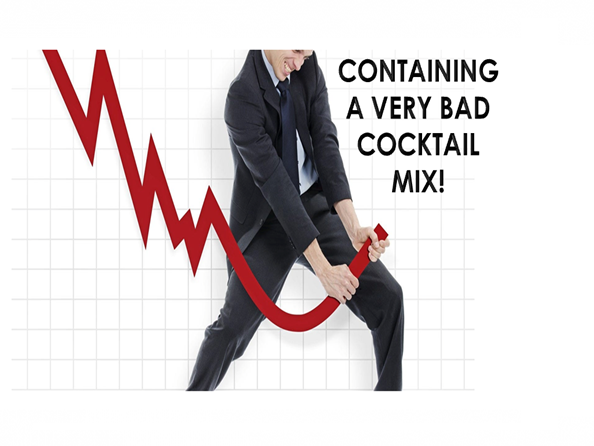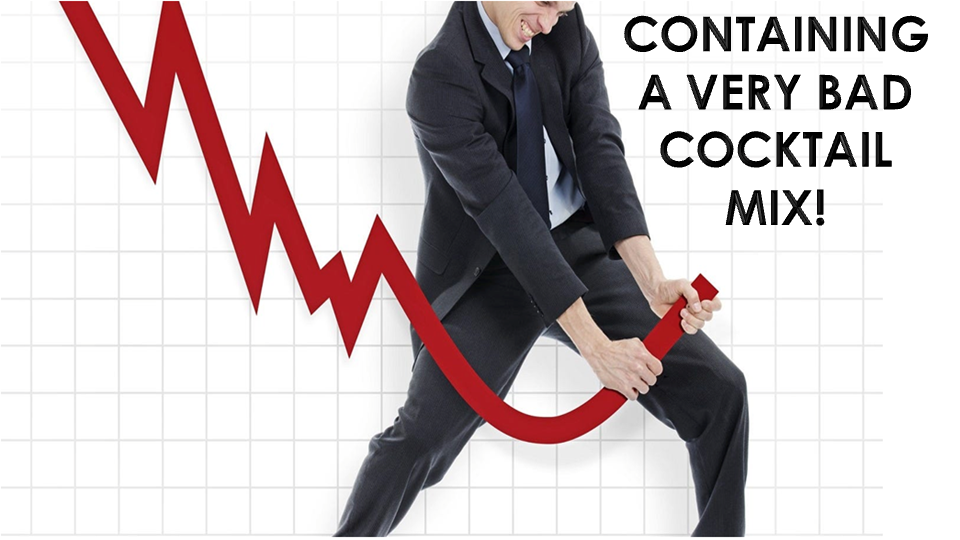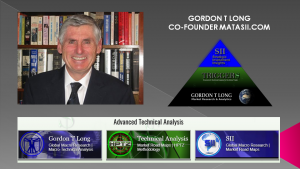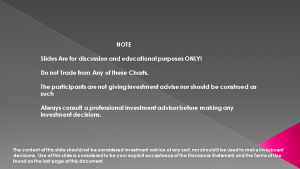IN-DEPTH: TRANSCRIPTION - UnderTheLens – 10-26-22 - NOVEMBER – Containing a Very Bad Cocktail Mix!
SLIDE DECK
TRANSCRIPTION
SLIDE 2
Thank you for joining me. I'm Gord Long.
A REMINDER BEFORE WE BEGIN: DO NO NOT TRADE FROM ANY OF THESE SLIDES - they are COMMENTARY for educational and discussion purposes ONLY.
Always consult a professional financial advisor before making any investment decisions.
COVER
The Federal Reserve is facing a very bad cocktail mix of problems which is going to be extremely difficult to contain:
- US overall Credit (adjusted for inflation) has contracted for the last three quarters,
- Asset prices of both bonds and stock have steadily fallen throughout 2022,
- The Fed has been forced to increase interest rates even more aggressively than it had planned only a few months ago!
- The Fed’s consensus Terminal Rate is now expected to be over 5%!
The Federal Reserve and US Treasury are only too acutely aware of all of this! So what is their plan?
AGENDA
We laid out what we expect in our latest Newsletter entitled “Watch Yellen, Not Powell!” Therefore we won’t address WHAT THEY WILL DO in this session as much as the boundary conditions they are operating under.
Conditions which as we spelled out in our newsletter we feel will force Powell via Janet Yellen’s US Treasury into using off-balance sheet “Contingent Liability” Loan Guarantees to pull their circuitous plan off.
As such we will cover the outlined items shown here.
SLIDE 6
A huge problem Fed Chairman Jerome Powell and US Treasury Secretary Janet Yellen face is the fact the shift from Capitalism to Creditism is now causing real problems as the shock of Covid-19, Lockdowns, Supply Chain disruptions and massive global liquidity injections to keep the global economy running are now taking their toll.
SLIDE 7
The shift from Capitalism to Creditism is best illustrated by the Blue and Black bars on this graphic. Saving is in blue which in a capitalistic system is reinvested into productive assets has steadily over the years been replaced with credit which is lost to consumption.
However, credit growth in black has been shrinking since the 2008 Financial Crisis and has been made up by the Fed’s Quantitative Easing (in green) and until recently by global investment into US Treasury debt (in red).
The bad cocktail mix is centered on:
- The reality of the Fed’s shift from QE to QT,
- A further US worsening of foreign investment in the buying of US treasury debt because of:
- Increasing global De-Dollarization as a result of the weaponization of US Dollar through sanctions as a US foreign policy tool,
- The US no longer the exporter it once was, so there is decreasing need for the US$ due increasing bi-lateral trade agreements in other currencies.
- … and NOW US Credit Creation is also further weakening at an alarming rate!
SLIDE 8
The net of this is that though Capitalism leads to higher standards of living, Creditism inevitably leads to lower standard of livings. That is what the US and other major developed powers are now facing).
When savings are reinvested into Productive Assets, these assets increase overall national labor productivity which directly increases standards of living. On the other hand when savings are small and are substituted for credit for primarily consumption it is only a matter of time before standards of living must fall. This is particularly an aggravating problem within in a 70% dependent consumption economy like the US.
SLIDE 9
The US and many of the developed economies have now reached the point of insufficient and unsustainable credit growth.
Let’s now more closely examine the element of the bad cocktail mix.
SLIDE 10
A Credit dependent economic system requires minimal levels of credit growth to avert slowing economic growth and a consequential crisis. As interest rates rise, credit obviously becomes less affordable.
However, when rates truly spike at a fast rate, as they have in 2022, this causes havoc in more than just the credit market -- as you will see in a moment.
SLIDE 11
Credit growth has been increasingly supporting economic growth in the US for decades. This has been particularly so since the US “off-shored” over 52,000 manufacturing facilities with the entry of China into the World Trade Organization (WTO) in 2002.
SLIDE 12
This dependency has surged from $1T in 1964 to ~$91T today. A 91 fold increase in 58 years.
SLIDE 13
What is important to understand is that when credit (adjusted for inflation) grows by less than 2% a year, the US economy historically goes into economic recession!
As shown on the right, credit growth has been noticeably weaker ever since the 2008 financial crisis.
SLIDE 14
Thanks to Chairman Ben Bernanke, when credit growth stalled following the 2008 financial crisis, he used Quantitative Easing on four separate occasions to push asset prices higher. The thinking was that rising asset prices harnessed the Wealth Effect that supplemented credit growth by boosting consumption and thereby grew the economy.
It has temporarily worked but has left us with some serious and crippling problems.
SLIDE 15
Thanks to the very low QE rates through these four QE rounds, household Wealth did increase. Unfortunately, it increased to a staggering $150T by the end of last year with an increase of $80T or 114% from the pre-crisis 2007 peak.
SLIDE 16
Once the Wealth Effect got going it took on a life of its own as the use of leverage, derivatives and financial engineering to capture more the wealth took over.
SLIDE 17
Now, suddenly, credit growth (again adjusted for Inflation) is contracting at the same time that plunging assets prices are wiping out trillions of dollars of wealth.
The increasing wealth was immediately used as collateral to leverage investor’s ability to capture further gains. This Credit collateral is now being wiped out. I encourage you to Google “rehypothecation” to fully appreciate the broad based global implication of this.
SLIDE 18
Total credit growth adjusted for inflation has now contracted by 1.7% Y-o-Y in the most recent quarter. That is well below the 2% US recession threshold.
Credit growth has contracted for three quarters in a row and it’s been below 2% for five quarters.
SLIDE 19
US Household wealth has contracted by $6T during the first half of 2022, but …
SLIDE 20
US Capitalization has plummeted by over $18T and globally by over $40T!
SLIDE 21
What is additionally seriously problematic, and as I have suggested already, is the rate of collapse! Wealth destruction in the 2nd quarter for the household sector was the largest ever recorded – and this was before the sector housing sector broke as mortgage rates spiked.
SLIDE 22
Even after the sharp correction, asset prices are still stretched by most historical measures.
At 778 in Q2 2022, the Wealth to Income Ratio is still 16% above its previous all time peak of 670 during the property bubble in 2007 and 2008.
SLIDE 23
With the Fed Funds rate still being well below the CPI at 40 year highs, the Federal Reserve appears well behind the curve.
SLIDE 24
The results of the surge in US rates have been a major unintended consequences around the world.
One of the biggest consequences has been in currency movements in almost all major currencies. On the surface the US dollar has been the biggest beneficiary as a result of a global “flight-to-safety”. However, this has set-off a chain reaction most evidently in highly leveraged Emerging Market economies. However, it is the currencies of the major developed economies that are receiving the current bulk of attention.
SLIDE 25
Stepping back we had a fragile global economic state as result of the Covid-19 global pandemic. This was a result of:
- Covid Lock-downs,
- A $30T Global Fiscal Stimulus Surge,
- Global Supply Chain Bottlenecks,
- An Energy Crisis,
- A Ukraine War & Sanctions,
- Mounting Emerging Market Food Shortages
The result was a serious unprecedented jolt to the global economic system as 32 major central banks were then suddenly forced to tighten credit as inflation violently struck.
SLIDE 26
A second shock has also insidiously hit as:
- The Rate of Increase of US Fed Funds Rate rose,
- The Rate of Increase of Real US Rate rose,
- The Rate of Increase of US Dollar rose,
- All while experiencing a diminishing level of Liquidity.
The result as been a global cost of, AND need for, Hedging.
SLIDE 27
- $40T in Lost Capital,
- Major Bond Volatility (VaR),
- Collateral Shortage Squeezes,
- Spiking FRA-OIS Rates
We are already seeing the fall-out of over-leveraged situations:
- In the UK with the LDI derivatives implosion within the Pension sector,
- With the SNB urgently needing $11B in US dollar Swaps,
- Major spikes in the cost of CDS’ for major global players like Credit Suisse,
- The National Bank of Belgium suddenly in a panic mode with the ECB.
SLIDE 28
All of this is resulting in a fracturing global derivative swaps market!
The unregulated, over-the-counter global Swaps market (solely reported on by the highly secretive BIS) has a notional value of over $600T in global cross border Interest Rate and Currency Swaps.
Anything that impacts the global swaps market has an exaggerated and non-linear shock to the global financial system.
SLIDE 29
If the current Put/Call Premium shown here is any indication (and it is) we are nearing an institutional panic in the credit and derivative market. Everyone appears on the side of the boat suggesting a near term market crash.
What this chart tells us from a contrarian perspective is that this has also proven to have actually been the point of a major market bounce! This may be another ultimate contrarian opportunity.
Why?
Historically, this is because the “powers-to-be” see the imminent problem and are forced into action. Their actions often take the form of changing the rules of the game or more blatantly (what I will call) simply “cheating”.
We can and should expect the unexpected to soon occur and in fact may already be occurring behind the curtain.
Not for one moment am I suggesting that action necessarily means an imminent Fed “Pivot”. Yes the “pivot” is coming, but it may still be off in the future after other games have been tried in an attempt to buy the Federal Reserve more time.
I list those games in our latest newsletter e-mailed to you or available online at MATASII.com. Also our prior newsletter addressed the issues in the global derivatives markets.
SLIDE 30
What do we expect in the near term?
You can never know for sure as we are basically at the hands of unelected bureaucrats.
SLIDE 31
Our long term dollar chart is telling us we are likely to soon see a retracement in the US dollar. This suggests a bounce would occur. A falling US Dollar would take some serious external intervention to occur, similar to the 1985 Plaza Accord where the US dollar strength was causing mayhem!
SLIDE 32
Long Term Bear market patterns suggest that we are near a cusp where we either reverse strongly upward or continue rapidly downward - both within new trend channel for extended periods of time.
SLIDE 33
This analogy against the 200o-2003 and 2008-2009 Bear Markets is pretty clear if we are going to see the typical 3-phases of a bear market.
SLIDE 34
I have shown this chart previously I like of long term earnings breadth. We have already experienced the typical extended anxiety period that precedes a final “capitulation” stage.
SLIDE 35
All this seems just too obvious and the markets seldom make anything obvious. What is more obvious however is that the powers-to-be must be considering some serious alternatives in conducting a surprise action?
Remember, these will only be tricks that may temporarily lift the markets but won’t create earnings. Ongoing weakening earnings will eventually prevail.
SLIDE 36
We can’t be certain -but we can be prepared!
SLIDE 37
What we are however certain of is that major Bear Markets take time. Typically they are in the range of 16 months and take the markets down 42%.
We have yet only experienced a 9 month decline of 26%.
SLIDE 38
We need to fully understand that the global economy is undergoing a major structural upheaval. This takes time to occur.
As a consequence we must expect major changes still lie ahead.
Central Banks are controlled by what is referred to as the “Unholy Trinity” where they can control only two out of three critical monetary levers. The levers being:
- A Pegged Exchange Rate
- An Independent Monetary Policy
- Free Capital Flows.
Most major powers have been operating within the construct of Independent Monetary Policy and Free Capital Flows without pegged exchange rate.
There is every likelihood that if history is any indication, that we will soon see differing changes to a countries preference in their selection of their Unholy Trinity. Most specifically we will see this in FX interventions to establish targets for their currencies.
SLIDE 39
We are already seeing the following significant actions or possibilities:
US TREASURY
-
- Active PPT – Blatantly Evident in FCI Index,
- $21B of US SDR’s to IMF,
- Yellen Soliciting Money Center Banks,
- Contingent Liability Guarantees
NATIONALIZATION
-
- GERMANY: Energy Broker
- FRANCE: Nuclear Sector
CAPITAL CONTROLS
YIELD CURVE CONTROL (YCC)
SLIDE 40
My three suggestions to you are:
- Don’t listen to what the Fed says – focus only on what they actually do,
- Watch US Treasury Secretary Yellen much closer than Chairman Jerome Powell for indications of what the powers-to-be are really up to,
- Monitor closely US Dollar and US Real Rate activity. These are the charts to have on your trading screens.
SLIDE 41
As I always remind you in these videos, remember politicians and Central Banks will print the money to solve any and all problems, until such time as no one will take the money or it is of no value.
That day is still in the future so take advantage of the opportunities as they currently exist.
Investing is always easier when you know with relative certainty how the powers to be will react. Your chances of success go up dramatically.
The powers to be are now effectively trapped by policies of fiat currencies, unsound money, political polarization and global policy paralysis.
SLIDE 42
I would like take a moment as a reminder:
DO NO NOT TRADE FROM ANY OF THESE SLIDES - they are for educational and discussion purposes ONLY.
As negative as these comments often are, there has seldom been a better time for investing. However, it requires careful analysis and not following what have traditionally been the true and tried approaches.
Do your reading and make sure you have a knowledgeable and well informed financial advisor.
So until we talk again, may 2022 turn out to be an outstanding investment year for you and your family.
Thank you for listening.






